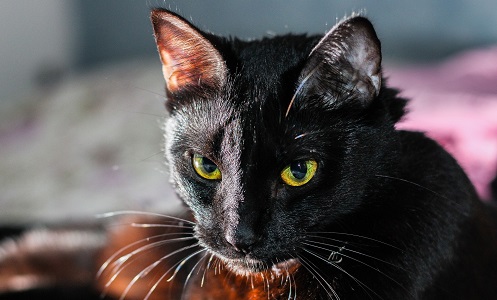Don’t think you can train a cat? Think again! Just like an old dog absolutely CAN learn new tricks (another popular myth), cats are often very receptive to training.
True, you likely won’t have much success trying to teach your cat to fetch or bring you the newspaper, but these behaviors aren’t the kind of training cats are receptive to. However, that doesn’t mean you can’t train your cat anything at all.
There are several things you can teach your cat, and your cat can be a willing and effective learner, in turn becoming a more enjoyable pet. In this post, we’re going to give you a helpful guide on how to train a cat, including proven tactics, strategies, and specific techniques. Training your feline friend can involve behavioral training as well as perhaps the most obvious form of cat training: litter box training.
Litter Box Training
Surprisingly, it actually isn’t that difficult to train a cat to use a litter box. Clean animals by nature, cats have a natural inclination to bury their waste. If you want to train your cat to use the litter box, start with the following simple steps.
- Make sure your cat eats a healthy diet and has plenty of water available at all times
- Place your cat and a clean litter box in a confined area (for example, your bathroom). Keep the litter box uncovered.
- If your cat does his business outside of the box, you will have to put the waste inside the box, and make sure your cat sees you doing it.
- After a day or two, the cat should catch on that they are supposed to go in the box, and will begin to go into the box on their own when they have to go to the bathroom.
- After a few days, if your cat still hasn’t started to use the litter box, you can try placing the cat in the box right after they eat. Scratch the surface of the litter with your finger. Make sure the litter box is clean. You may even have to try a different type of litter — cats can be particular about this! And make sure the litter box is in a quiet, secluded area, as cats are very private about doing their business.
- Consult your veterinarian if none of these strategies seem to work. There may be an underlying medical problem that is causing your cat’s reluctance.
While litter training will come first and foremost, there are plenty of other actions and behaviors that you can teach your cat.
Understanding Your Cat
 There is plenty you can train a cat to do beyond litter training, however, how willing your cat will be to learn depends on the individual. If you’re lucky, your cat will be eager to train with you, however, others may completely ignore you. This can be extremely frustrating and test your patience, so be aware. Cats are also fiercely independent, so each one will need to be taught differently.
There is plenty you can train a cat to do beyond litter training, however, how willing your cat will be to learn depends on the individual. If you’re lucky, your cat will be eager to train with you, however, others may completely ignore you. This can be extremely frustrating and test your patience, so be aware. Cats are also fiercely independent, so each one will need to be taught differently.
But just like dogs, cats will be motivated to do things that will benefit them. Since cats most often seek out food or play from their owners rather than the other way around, you can use this to your advantage. You have to handle training a cat differently than training your dog, however, as cats don’t respond to many of the methods used in dog training.
In order to train your cat, you will need to be able to understand him more than you would a dog. Cats aren’t nearly as social as dogs since felines were bred to kill vermin on their own, while dogs were bred to work in tandem with humans on various tasks. This makes cats inherently independent, and they won’t work as hard for your attention or love like a dog will.
Some won’t be easily motivated to do much of anything at all, so you will likely have to find some truly irresistible treats to get your cat to train. Cat training will require a great deal of patience and even some creativity, but it can be a rewarding process if you give it the time.
Training will stimulate your cat’s mind, which can have added health benefits and even help to extend your cat’s lifespan, plus you will strengthen your bond by spending the time together training. You may even be able to teach your cat a fun trick in addition to useful behaviors.
Use Tasty Treats That Your Cat Loves
Dogs are much easier in this regard, but for a cat, you will need to find a treat that they find truly irresistible. Have you ever seen a cat react to the smell of tuna? That’s what you’re looking for.
In fact, bits of tuna works great as a treat in training. You can also use small pieces of chicken, meat-flavored baby food, or commercial cat treats that they respond well to. Identify any treat your cat will go crazy for and use that in your training sessions.
Keep Your Training Sessions Short
Just like dogs, cats have short attention spans and can become easily bored rather quickly. Keep your training sessions short to maximize their attention and just focus on one command or behavior at a time. Once your cat has mastered the behavior, you can move on to another.
You should limit training sessions to just a few minutes at a time, and make sure to make the experience easy for both of you. Short sessions give you the best chance of keeping your cat coming back for more.
Use Positive Reinforcement, Not Punishment
Cats respond very poorly to punishment, so it is extremely important to keep training sessions positive. If you punish your cat, he will typically just run away, rather than learn that a behavior is good or bad. You can stress your cat out and cause him to hide from you, or even develop other behavioral issues like feline spraying.
You’ll find training much easier if you reward the behaviors you want rather than punishing those you don’t. Offer positive alternatives rather than punishing your cat so you can persuade them into the desired behavior. Use patience, and reward your cats with treats, that way they will be more receptive to learning.
Clicker Training
Using a clicker is very common in training a cat, and can make the process much easier and faster. A form of reward-based training, using a clicker helps to reinforce good behavior. The second a cat does the desired behavior, you hit the clicker, then reward them with a treat. With repetition, your cat will learn to associate the click with the behavior and reward.
Clicking at the moment your cat performs an action or behavior lets them know they are doing the right thing, which helps them to learn faster. With short training sessions and repetition, your cat should catch on rather quickly.
Behavior Training
Sometimes, cats can develop behaviors that you would like to see them grow out of. Rather than waiting for that to happen, you can often train the bad behavior out of them yourself.
This will involve trying to learn why the cat is behaving a certain way. A behavior like scratching furniture is in the cats’ nature — it’s a survival instinct for cats to keep their claws sharp. In this instance, you can train your cat to use a scratching post rather than your furniture.
Don’t hit or yell at the cat when he scratches furniture, but reward him when you see him scratching the post. There’s little chance you can get the cat to stop scratching, so divert his attention away from your furniture and to the scratching post for a happy home.
Beyond clawing up your furniture, there are other common cat behavioral problems that can be addressed through training. These may include spraying and urinating, becoming aggressive toward other people or animals, stress, fear or cat anxiety, and over-grooming.
There may be several things that cause your cat to act out, including stress, a move, a medical condition, or simply not understanding that they are doing anything wrong. Most often, the cat is not being spiteful, regardless of your suspicion. With any behavioral issue, you can redirect the problem rather than punishing the cat for it. Punishing causes the cat to fear you, which may lead to even more stress and bad habits.
Discouraging Aggression
Cats can sometimes play a little too rough just like dogs do, and scratch and bite. You can often train this behavior out of your cat, at least to a degree.
If your cat begins scratching or biting while playing, you can startle it with a loud noise, or clap your hands and make a hissing noise. This will startle the cat to stop what he is doing, at which point you can simply walk away. Repeat this process any time the cat is playing too rough, and he will learn that playtime ends when the behavior happens.
Teaching Your Cat to Sit & Give a High-five
 All cats sit, which makes training them to sit quite easy. Simply say “sit” when your cat sits, and praise them with some putting and/or a treat. You can also use the clicker here at the moment they sit, followed by a treat. Eventually, you can incorporate a hand signal, which the cat will identify with the behavior.
All cats sit, which makes training them to sit quite easy. Simply say “sit” when your cat sits, and praise them with some putting and/or a treat. You can also use the clicker here at the moment they sit, followed by a treat. Eventually, you can incorporate a hand signal, which the cat will identify with the behavior.
From here, you can often take things to another level and teach your cat to give you a high-five. Encourage your cat to touch his paw to your hand by keeping their treat wrapped in your first. When they use their paw to try and grab it, give them the treat, and praise them for their good deed. You can then start to lift your hand higher and reward them each time they touch your hand.
A good time to train your cat to sit is when you are preparing their dinner. Get your cat’s attention, move food in front of their face to just beyond their ears, and it should make them naturally go to a sitting position. Offer the treat the second their butt hits the floor, and repeat until they sit on their own when it’s time for dinner.
Training a Kitten
If you bring your cat home when they are still a kitten, you should start training as soon as possible. This gives you the best chance to have a well-behaved cat throughout their lifetime. You’ll keep your cat’s mind and body active while teaching them good behaviors that will form a good relationship between you two.
Toys and treats are the best motivators with kittens, as well as lots of play and loving attention. You can use toys as distractions to avoid bad behaviors and reward them with treats when they comply. Catnip can also be a powerful ally.
Summary
Overall, training a cat can be a productive experience and one worth your while. Despite long-held opinions to the contrary, cats will often be agreeable to training, and at the very least can be taught to use their litter box. Don’t be discouraged by your cat’s independence, as it does not necessarily mean they have no interest in training. They just aren’t desperate to please like dogs! Training a cat can still be fun and rewarding, just give it a try.




